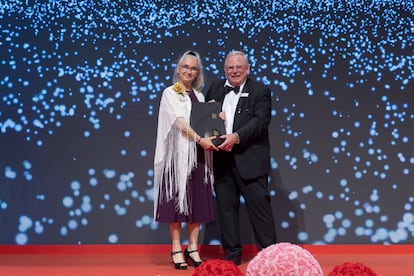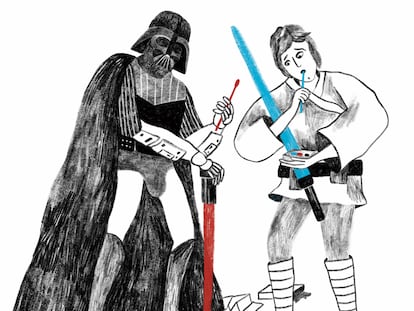The daughter of a shepherd and an embroiderer is in the running to win a Nobel Prize
The Spanish biophysicist Eva Nogales has just received the $1.2 million Shaw Prize for revealing the atomic intricacies of human beings
Spanish scientist Eva Nogales is in the running to win the Nobel Prize… and her background is unusual among those who tend to be in contention.
“My father was a sheepherder and my mother was an embroiderer. They couldn’t finish their basic education, because they had to go to work when they were 11 or 12-years-old,” Nogales explains. She was born 58 years ago in the town of Colmenar Viejo, about 20 miles north of Madrid. Her parents’ main goal was to save money, so that their children could study. Nogales entered the Faculty of Physics of the Autonomous University of Madrid in 1983.
“There were a lot of parties, a lot of drugs, a lot of sex… but I had no money, and I was a nerd. I missed Madrid’s La Movida scene, I was in the library,” she remembers with a laugh. The researcher has just received the $1.2 million Shaw Prize. Awarded in Hong Kong, it’s considered to be the Nobel Prize of the East. One in every seven winners has also ended up winning the Nobel Prize.
All humans were first a single cell, the result of the union between an egg and a sperm. That solitary cell already has exclusive DNA, a manual with enough instructions to multiply and become a unique human being, with 30 billion cells. Molecular machinery reads that DNA and — depending on the sections it reads — the cell becomes a neuron in the brain, a red blood cell, or any other type of cell. Nogales — who has spent half her life at University of California, Berkeley — has managed to visualize, for the first time, atom by atom, the convoluted structure of the main proteins that read DNA. This reading process — called “transcription” — is essential in life and death. When it fails, it can lead to serious diseases, such as cancer.
American geneticist Francis Collins — a devout Christian and former director of the Human Genome Project — calls DNA “the language of God.” At the Shaw Award ceremony, Eva Nogales showed a portrait of herself as a child, at her first communion. “I was 10-years-old when [Spanish dictator Francisco] Franco died. We were all raised in religion; we prayed every day at school. We believed in guardian angels and things like that. I had a lot of faith. But there was a certain moment in which I began to be more critical and began to see holes [in religion], both from the theological and social points of view,” she explained. “In the end, I quit. Religions exist everywhere because we want to give meaning to our life and our death, which scares us. I would love to believe that religion has a role to play,” she concluded.
Nogales — passing through Madrid to celebrate Christmas with her family in Colmenar Viejo — answers questions from EL PAÍS in a room at the National Cancer Research Center, where she’s an affiliate.
“You study the matter of life at the atomic level. What are we made of?”
“Well, atoms,” she replies, “like everything else. Our atoms come from supernovas [star explosions] and things like that. We’re mostly carbon, oxygen, nitrogen and hydrogen. Phosphorus — which is part of DNA — is also important. In the end, we’re made of super simple atoms, which are combined in thousands of different ways.”
American chemist Roger Kornberg won the 2006 Nobel Prize in Chemistry after describing the structure of a protein involved in reading DNA. “Life is chemistry, nothing more and nothing less. Although people resist this idea,” Kornberg stated, in an interview with this newspaper four years ago. Eva Nogales — as a biophysicist — agrees. “Life is chemistry,” she affirms “In the end, in biology, everything is chemistry.” The researcher emphasizes that the enormous complexity of the proteins that make up all living beings is built with only 20 amino acids, molecules that act like 20 different Lego pieces. “With only 20 units, we have all the beauty of life, from a bacterium to an elephant, including a sea sponge,” Nogales proclaims.
The Shaw Prize was established in 2004 by Run Run Shaw, a Hong Kong film and press magnate, who died a decade ago. The producer of legendary kung-fu films, such as The Shaolin Avengers (1976), and global hits such as Blade Runner (1982), the wealthy patron wanted to reward scientists who illuminate the intricate mysteries of nature, such as Eva Nogales. She shared this year’s award with her colleague, Patrick Cramer, president of the Max Planck Society of Germany.
Nogales has mastered the electron cryomicroscope, a revolutionary instrument capable of photographing molecules that are essential for life at temperatures of about 180 degrees below zero. Its inventors won the 2017 Nobel Prize in Chemistry. Nogales’ research team takes “a million photos” of the same protein and combines the images with supercomputers, until they obtain the three-dimensional structure, atom by atom. Her group at Berkeley has thus revealed the shape of key proteins, such as tau — which forms tangles within the brain cells of people with Alzheimer’s — or telomerase, which is activated in cancer cells and causes them to multiply without restraint.
“You can’t fix a car if you don’t know how it works. First, you have to get to know its engine under normal conditions. And the same thing goes for nature,” Nogales warns. Her first major scientific success came in 1998, when her group revealed the structure of tubulin, a protein that acts as the skeleton of cells. The discovery became the cover story of Nature, one of the world’s top science journals. “EL PAÍS used an entire page to announce it that Sunday and I became famous in my town,” she remembers with a laugh.

In 2014, biophysics revealed the functioning of paclitaxel, a drug that has saved millions of lives thanks to its effectiveness against breast, ovarian and lung cancer, among other types of cancer. The drug — based on an extract of bark from a North American tree, the Pacific yew — binds to tubulins and causes tumor cells to stop multiplying. That same year — alongside her colleague Jennifer Doudna — Nogales elucidated the structure of Cas9, a key protein in the revolutionary CRISPR gene editing system. Doudna went on to win the 2020 Nobel Prize in Chemistry.
Since 2021, Nogales’ 87-year-old mother can proudly walk along a street that bears her daughter’s full name: Evangelina Nogales de la Morena Avenue, in Colmenar Viejo. Her father died before he could see it. While the biophysicist moved to Berkeley in 1993, she has reclaimed her roots. The day after her interview with EL PAÍS, she met with three teachers from her old high school, who helped her fall in love with science more than 40 years ago: Ana Cañas, who taught her Physics; Ana de Frutos, who taught her Biology and Avelina Lucas, from the Math department.
The day she collected the Shaw Prize in Hong Kong, Nogales went on stage wearing a Manila shawl that she had purchased in Madrid. “They’re beautiful, and I can’t think of a more Spanish accessory!”
Sign up for our weekly newsletter to get more English-language news coverage from EL PAÍS USA Edition
Tu suscripción se está usando en otro dispositivo
¿Quieres añadir otro usuario a tu suscripción?
Si continúas leyendo en este dispositivo, no se podrá leer en el otro.
FlechaTu suscripción se está usando en otro dispositivo y solo puedes acceder a EL PAÍS desde un dispositivo a la vez.
Si quieres compartir tu cuenta, cambia tu suscripción a la modalidad Premium, así podrás añadir otro usuario. Cada uno accederá con su propia cuenta de email, lo que os permitirá personalizar vuestra experiencia en EL PAÍS.
¿Tienes una suscripción de empresa? Accede aquí para contratar más cuentas.
En el caso de no saber quién está usando tu cuenta, te recomendamos cambiar tu contraseña aquí.
Si decides continuar compartiendo tu cuenta, este mensaje se mostrará en tu dispositivo y en el de la otra persona que está usando tu cuenta de forma indefinida, afectando a tu experiencia de lectura. Puedes consultar aquí los términos y condiciones de la suscripción digital.
More information
Archived In
Últimas noticias
Welcome to the post-religion era: The idea of Christianity as the absolute truth has become obsolete
‘I thought you would like it’: The risky sexual practice popularized by TV shows and TikTok
The digitalization of tourism: ‘They promise experiences and gave us the worst possible one’
Mexican peso defies uncertainty with forecasts of a new period of stability in 2026
Most viewed
- Sinaloa Cartel war is taking its toll on Los Chapitos
- Reinhard Genzel, Nobel laureate in physics: ‘One-minute videos will never give you the truth’
- Oona Chaplin: ‘I told James Cameron that I was living in a treehouse and starting a permaculture project with a friend’
- Why the price of coffee has skyrocketed: from Brazilian plantations to specialty coffee houses
- Silver prices are going crazy: This is what’s fueling the rally










































